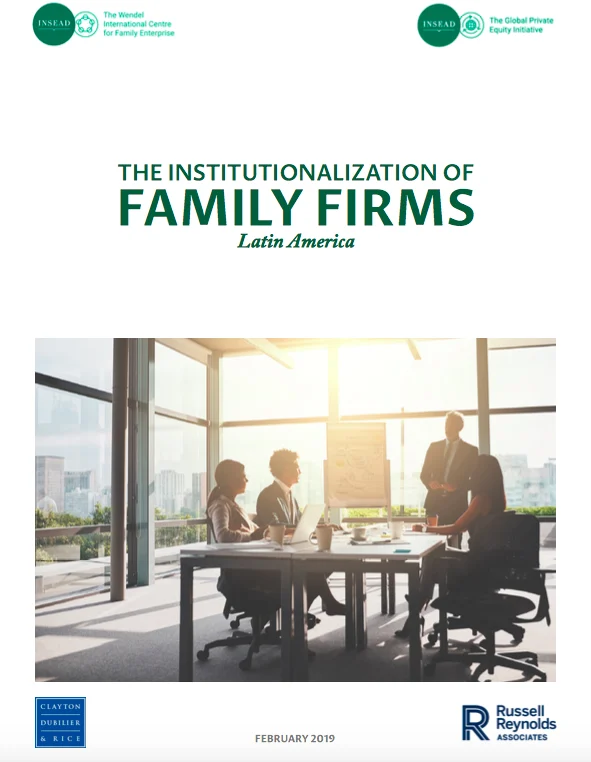As we noted last week: INSEAD has released a new report — The Institutionalization of Family Firms: A Look at Latin America.
The report is written by Claudia Zeisberger, Senior Affiliate Professor of Entrepreneurship and Family Enterprise and the Academic Director of GPEI, and Morten Bennedsen, The André and Rosalie Hoffmann Chaired Professor of Family Enterprise Professor of Economics and Political Science Academic Director, Wendel International Centre for Family Enterprise.
They write: “Family owned and controlled firms form the backbone of Latin American economies, accounting for 75% of all $1 billion-plus businesses in the region and 60 percent of its aggregate GNP. It follows that family businesses must create value and thrive for the economic well-being of their home countries. So how can family firms ensure long-term value creation?”
“As family businesses mature it is critical that they embark on a process of institutionalization whereby they introduce and embed formal policies and procedures that strengthen commitment to their mission and values, preserve their competitive advantage and facilitate long-term growth.”
To create the report “INSEAD surveyed 131 family firms and interviewed select PE experts to understand the dynamics of the region. This report examines how institutionalization can help a family business secure its long-term survival and unlock growth. It includes an analysis of the survey results and individual case studies that can help family firms understand their own strengths and weaknesses and learn from their peers. It also explores partnership opportunities between family firms and PE investors and uncovers areas of best practice that support sustainable value creation.”
Survey Findings
 The authors employed a survey that looked at six attributes. (Note: They “grouped first-generation, second-generation and third-generation family firms as “Ascendants’ and older family firms as ‘Champions.’ The difference between the institutionalization scores of the two groups is defined as the ‘proficiency gap.’”
The authors employed a survey that looked at six attributes. (Note: They “grouped first-generation, second-generation and third-generation family firms as “Ascendants’ and older family firms as ‘Champions.’ The difference between the institutionalization scores of the two groups is defined as the ‘proficiency gap.’”
- Growth capabilities: “In Latin America, Champions outdid Ascendants with a proficiency gap of 28 percent in identifying and executing growth strategies. They executed significantly more mergers and acquisitions and showed slightly stronger organic growth. Champions were also less affected by regulations, government corruption and changes in macroeconomic policies.”
- Organizational design: “In evaluating the systems and policies that govern daily operating activities, Champions fared better than Ascendants with a proficiency gap of 24 percent. That was because Champions had better human resource and spending policies. They also had generally stronger information systems, and followed more formal resource allocation and reporting processes.”
- Corporate governance and leadership: “Champions drove the 20 percent proficiency gap in this category, but Ascendants scored higher in terms of their incentive schemes and the diversity of their management teams. Just 66 percent of Ascendants had a board of management, while all Champions had one.”
- Access to capital: “The proficiency gap in this category was 17 percent, largely because Champions had greater access to debt finance while also having lower percentages of debt on their balance sheets. Slightly more Champions were publicly listed than Ascendants. They also had marginally better access to additional family funding. However, both groups were almost equally as likely to have raised equity capital from outside investors.”
- Intangible family assets: “Champions’ family values, connections and heritage were of greater strength and importance, accounting for a proficiency gap of 7 percent. But Champions and Ascendants had a surprisingly modest difference in terms of shared mutual core values and family values with the current chief executive. Ascendants had slightly higher scores on ties with government officials and other business families. But Champions led on relationships with customers and suppliers.”
Family ownership and succession: “Champions fared only a little better in this category with a proficiency gap of 4 percent. That they did not have significantly higher succession planning scores was surprising. Compared with Ascendants, Champions had slightly fewer disagreements on this issue and were marginally more likely to have started discussing a succession plan. On the use of an indirect shareholding model, more Champions than Ascendants used trusts, foundations or family holding companies to house their equity stakes.”
Citations
- https://workingcapitalreview.com/2019/04/institutionalization-of-family-firms-latin-america/
- https://www.insead.edu/sites/default/files/assets/dept/centres/gpei/docs/The_Institutionalization_of_Family_Firms_Latin_America_Mar_2019.pdf
- https://www.insead.edu/faculty-research/faculty/claudia-zeisberger
- https://www.insead.edu/faculty-research/faculty/morten-bennedsen
- https://knowledge.insead.edu/economics-finance/latin-american-family-firms-and-the-path-to-longevity-11331
